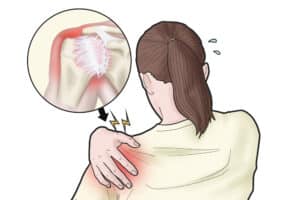Baker’s cyst, also known as a popliteal cyst, is a fluid-filled swelling that develops at the back of the knee. It is often associated with conditions that cause joint inflammation, such as arthritis or knee injury. This common knee problem can cause discomfort and restrict movement, but physiotherapy offers a range of treatments that can help alleviate symptoms and improve quality of life. In this blog post, we’ll delve into what Baker’s cyst is, how it’s diagnosed, and the effective physiotherapy interventions that can manage or even resolve the condition.
What is Baker’s Cyst?
A Baker’s cyst forms when excess joint fluid is produced by the knee, leading to swelling in the popliteal bursa at the back of the knee. This can be due to various underlying issues, including osteoarthritis, rheumatoid arthritis, or meniscus tears. The cyst typically appears as a bulge and a feeling of tightness behind the knee, which might worsen when the knee is fully extended or during physical activity.
Symptoms of Baker’s Cyst
The symptoms of a Baker’s cyst vary, but typically include:
Swelling: The most noticeable symptom is swelling behind the knee and into the leg, often exacerbated by prolonged activity.
Pain: Varies in intensity; can increase when the knee is active or fully extended.
Stiffness: The knee may feel stiff, especially in the morning or after sitting for long periods.
Limited Mobility: There might be a noticeable difficulty in fully flexing or extending the knee without discomfort.
Tightness: A feeling of tightness in the back of the knee that may become more pronounced with activity.
In some cases, the cyst can rupture, leading to sharp pain, significant swelling in the lower leg, and even mimic symptoms of a blood clot.
Baker’s Cyst Diagnosis
Diagnosis of a Baker’s cyst begins with a physical examination where a healthcare provider assesses the knee for swelling and tenderness. The clinical evaluation may include range of motion tests to see how the movement of the knee is affected. Imaging tests, such as ultrasound or MRI, are often recommended to confirm the diagnosis, assess the size of the cyst, and rule out other conditions such as tumors or deep vein thrombosis.
Differential Diagnosis
According to Physio-Pedia.com, “Baker’s cyst can be mistaken for several other injuries in the knee. The patient’s history, as well as the clinical investigation and imaging, allow for proper differential diagnosis of the disease.”
Conditions presenting as soft tissue masses in the posterior leg
Muscle strain or tear
Palpable mass/tenderness, swelling/warmth, pain on contraction and/or stretch of muscle
Muscle contusion or hematomas
Local damage to muscle (bleeding, swelling), painful muscle contraction/stretch. If the hematoma is old, organized thickening is developed
Muscle spasm or cramp
Painful palpable lump/thickening, possible range of motion restriction, pain on stretch of muscle
Fascial tear with muscle herniation
Palpable soft mass, severe muscle pain with increased activity. localized swelling post activity
Myositis ossificans
Palpable painful mass in the muscle, microtears in the muscle fibers that cause pain and swelling with muscle contraction or stretch, loss of motion from restricted muscle function
Deep vein thrombosis (DVT)
Constant pain, pain on passive dorsiflexion (Homan’s sign), localized warmth, localized tenderness on calf palpation and possible swelling, elevated body temperature
Benign tumor
Localized pain and tenderness, may be palpably soft or hard, may cause movement dysfunction (location dependent)
Malignant tumor
Generalized malaise, possible sudden weight loss, localized pain and/or swelling various sizes and consistency
Hemangioma
Present for a long time, slow changes in size over time. palpable lump, may be painful, may/may not limit motion
Baker’s cyst
Palpable lump with possible tenderness in posterior knee and posteromedial calf
Ruptured or enlarging Baker’s cyst (pseudothrombophlebitis)
Can mimic DVT, swelling in the calf, acute pain that worsens with compression
“Popliteal Cyst may also be confused with lipoma, which would represent less resisting pressure when compared to a Baker’s cyst or aneurysm differentiated by Doppler evaluation (ultrasound).”
“Some examples of supporting and negating evidence of the possible diagnoses are:”
Differential diagnoses of mass in the calf muscle
Possible Diagnosis: Old muscle strain or trauma with scar tissue
Supporting Evidence: Palpable mass
Negating Evidence: No previous history of a muscle tear or trauma, no pain with running
Possible Diagnosis: Fascial tear with muscle herniation
Supporting Evidence: Pain walking more than 0.5 km. palpable tenderness
Negating Evidence: Nonincident related, insidious onset. No pain with running or general exercise
Possible Diagnosis: Localized muscle spasm
Supporting Evidence: Pain walking more than 0.5 km. palpable tenderness
Negating Evidence: No pain on passive calf stretch, no pain on resisted muscle contraction, no limitation of motion in foot or knee
Possible Diagnosis: Deep vein thrombosis (DVT)
Supporting Evidence: Palpable tenderness, pain, sitting with legs crossed, family history of increased clotting factor XII in blood, taking oral contraceptive agents
Negating Evidence: No history of DVT, no recent immobilization, no edema, no raised body temperature, negative Homan’s sign, local pulses present
Possible Diagnosis: Benign tumour
Supporting Evidence: Palpable mass, palpable tenderness, insidious onset
Negating Evidence: No weight loss, no night pain or feeling unwell, intermittent pain, good general health
Possible Diagnosis: Malignant tumour
Supporting Evidence: Palpable mass, palpable tenderness, insidious onset
Negating Evidence: Intermittent pain
Possible Diagnosis: Hemangioma
Supporting Evidence: Palpable mass, palpable tenderness, insidious onset
Negating Evidence: Insidious onset, unknown cause, hormonal changes (oral contraceptive agents), present for a long time, slow changes in size over time. palpable lump. may be painfully may not limit motion
Role of Physiotherapy in Managing Baker’s Cyst
Physiotherapy is a pivotal part of managing Baker’s cysts, focusing on reducing symptoms and addressing the underlying causes. Here’s how physiotherapy can help:
Pain Management: Techniques like ice therapy, soft tissue massage, and transcutaneous electrical nerve stimulation (TENS) can be used to manage pain.
Improving Flexibility and Strength: Targeted exercises can help improve flexibility and strengthen the muscles around the knee, stabilizing the joint and reducing the strain on it.
Mobilization: Gentle mobilization techniques can be employed by physiotherapists to increase knee mobility and decrease discomfort.
Education and Activity Advice: Physiotherapists can provide valuable advice on activity modification that limits stress on the knee. They also guide on proper knee care and preventive measures.
Ultrasound Therapy: Some physiotherapists may use ultrasound therapy to promote healing by reducing inflammation.
Compression: In some cases, compression bandaging or taping may be recommended to support the knee and reduce swelling.
Prevention and Lifestyle Modifications
Preventing the recurrence of Baker’s cyst primarily involves addressing the underlying conditions that cause it. Regular exercise to maintain strength and flexibility, weight management, and avoiding activities that strain the knee can be helpful strategies. Additionally, wearing appropriate footwear and using assistive devices such as braces can support knee health.
Baker’s Cyst Can Be Treated
While Baker’s cyst is uncomfortable and limits activities, physiotherapy offers effective treatments that can significantly improve symptoms and mobility. If you suspect that you have a Baker’s cyst or experience knee pain and swelling, consulting a physiotherapist or healthcare provider is a crucial step towards recovery. Through a personalized treatment plan, physiotherapy can help you return to your normal activities with less pain and more confidence in your knee’s stability.
This comprehensive approach not only alleviates the symptoms but also enhances the overall functionality of the knee, ensuring that you can enjoy a higher quality of life without being held back by pain and discomfort.
Common Questions About Baker’s Cyst
1. What exactly is a Baker’s cyst?
Answer: A Baker’s cyst, also known as a popliteal cyst, is a fluid-filled sac that forms behind the knee. It results from fluid accumulation in the knee joint, often due to inflammation or injury. Conditions like arthritis, cartilage tears, and other knee injuries can lead to the development of a Baker’s cyst.
2. What causes a Baker’s cyst?
Answer: The primary cause of a Baker’s cyst is excess joint fluid produced in response to an inflammation or injury within the knee. Common underlying causes include osteoarthritis, rheumatoid arthritis, and meniscus tears.
3. What are the symptoms of a Baker’s cyst?
Answer: Symptoms include swelling behind the knee and into the calf, pain in the knee, stiffness and restricted movement. The cyst may feel like a water-filled balloon and is usually soft and compressible. In severe cases, the cyst can burst, leading to sharp pain and swelling in the lower leg.
4. How is a Baker’s cyst diagnosed?
Answer: Diagnosis typically involves a physical examination, where a doctor may feel the swelling. Imaging tests such as an ultrasound or MRI are often used to confirm the diagnosis and rule out other possible causes of the symptoms, like a blood clot or tumour.
5. Can a Baker’s cyst lead to serious complications?
Answer: In most cases, Baker’s cysts are not serious and can be managed effectively. However, complications can occur if the cyst bursts, which can lead to increased pain and swelling. This can mimic the symptoms of a deep vein thrombosis (DVT), a serious condition that requires immediate medical attention.
6. How is a Baker’s cyst treated?
Answer: Treatment depends on the underlying cause and the severity of symptoms. Options may include:
- Medication: To reduce inflammation and pain
- Physiotherapy: Exercises and modalities to improve joint function and reduce fluid accumulation.
- Aspiration: Draining the cyst with a needle (sometimes guided by ultrasound).
- Surgery: In rare cases, surgical removal of the cyst may be necessary if it causes significant pain or interferes with joint movement.
7. Can a Baker’s cyst go away on its own?
Answer: Yes, a Baker’s cyst can sometimes resolve without treatment, especially if it’s small and not causing symptoms. Addressing the underlying condition, such as managing arthritis, can also lead to resolution of the cyst.
8. What lifestyle changes can help manage a Baker’s cyst?
Answer: Lifestyle changes that may help include maintaining a healthy weight to reduce stress on the knees, regular moderate exercise to strengthen the muscles around the knee and maintain joint function, and using supportive devices like knee braces when necessary.
9. Should I avoid certain activities if I have a Baker’s cyst?
Answer: It’s advisable to avoid activities that strain the knee or cause pain. Low-impact exercises such as swimming or cycling might be more suitable. Always consult with a healthcare professional for personalized advice.
10. When should I see a doctor for a Baker’s cyst?
Answer: You should consult a doctor if you notice swelling behind the knee, experience knee pain that worsens or doesn’t improve, or if you have any concerns about your symptoms. It’s particularly important to seek immediate medical attention if you experience symptoms like severe swelling, redness, or pain in the calf, which could indicate a burst cyst or DVT. These answers can serve as a helpful guide for those experiencing symptoms or managing a diagnosed Baker’s cyst, offering a clearer understanding and direction for seeking appropriate care.
Get Started Today!
Seeing a professional physiotherapy provider like Nova Physiotherapy can offer expert care, personalized treatment, education, and a holistic approach to Baker’s cysts. If you’re considering physiotherapy, contact the friendly and experienced team at Nova Physiotherapy. We’re ready to help you on the road to better health.








